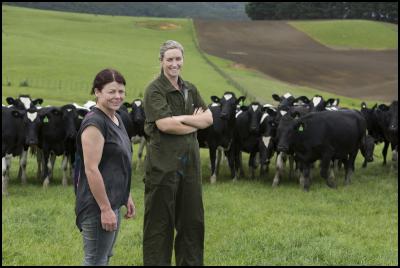BVD vaccination helps good heifers realise potential

Verena Beckett (left) and
veterinary technician, Jess Kingsland: BVD testing and
annual vaccination have helped reduce the impact of the
disease on replacement heifers.
7 November 2016 For immediate release
BVD vaccination helps good heifers realise potential
When you’re raising big, strong and healthy looking heifers to bring into the milking herd, it can be extremely frustrating when they fail to fire. That’s what was happening for northern Waikato farmer Verena Beckett and she was keen to find out what was holding the first calvers back.
Beckett runs a 400-cow dairy herd on her father’s 160-hectare property at Rotongaro, west of Huntly. But it was on her own adjacent 165-hectare farm, also running 400 Friesians, where the trouble was brewing.
Her replacements are raised as part of a grazing scheme run by Franklin Vets (Te Kauwhata) on a separate sheep and beef property northeast of Te Kauwhata. They were, according to veterinary technician Jess Kingsland, “monster” heifers in great condition. But the naturally mated animals were experiencing empty rates of 8–10 percent and calving was very spread out.
Kingsland says blood tests carried out several years ago under an MSD Animal Health heifer screening programme had shown there had been exposure of stock to bovine viral diarrhoea virus (BVDv), so the disease was in the frame as a possible culprit for the less-than-stellar reproductive performance in the heifers.
Beckett said bulk milk tests for BVD were not showing anything significant, but the disease is a “sneaky” one so couldn’t be ruled out.
Bulls are a well-known pathway for BVD infection, but those used for Beckett’s heifers are all tested and vaccinated. Kingsland says no persistently infected (PI) animals were found among the heifers, so any transient infection with BVD may have come from “over the fence” contact with PI animals or contact with other mobs on the grazing property. It is also a working sheep and beef farm and beef cattle are traded regularly, providing plenty of opportunity for the disease to find its way into the grazed heifers.
Biosecurity was a likely issue but it wasn’t going to be possible to prevent contact with other cattle, either over the fence on neighbouring properties or at the grazing property.
On the advice of her veterinarian, Beckett has started an annual vaccination programme with Bovilis BVD to protect her heifers from the disease. She’s noticed an immediate improvement. “This year we had 80 percent of our heifers calved within the first three weeks and by the end of August only four were left to calve. The empty rate is also much lower now.”
The calves, once at least four months of age, receive their initial sensitiser and booster shots four weeks apart before they go off to grazing. As adults they receive an annual booster, four weeks before mating.
Beckett now vaccinates her entire herd to help manage the risk to her productivity from BVD. “There’s definitely a cost involved, but it’s hard to put a price on getting all your heifers in calf and calving early.”
She’s now signed up to LIC’s BVD testing scheme as part of an ongoing monitoring programme to shut the door on the disease.
--- ends
---


 John Mazenier: Gaffer Tape And Glue Delivering New Zealand’s Mission Critical Services
John Mazenier: Gaffer Tape And Glue Delivering New Zealand’s Mission Critical Services Earthquake Commission: Ivan Skinner Award Winner Inspired By Real-life Earthquake Experience
Earthquake Commission: Ivan Skinner Award Winner Inspired By Real-life Earthquake Experience Reserve Bank: Consultation Opens On A Digital Currency For New Zealand
Reserve Bank: Consultation Opens On A Digital Currency For New Zealand NIWA: Ship Anchors May Cause Extensive And Long-lasting Damage To The Seafloor, According To New Research
NIWA: Ship Anchors May Cause Extensive And Long-lasting Damage To The Seafloor, According To New Research New Zealand Customs Service: A Step Forward For Simpler Trade Between New Zealand And Singapore
New Zealand Customs Service: A Step Forward For Simpler Trade Between New Zealand And Singapore Horizon Research: 68% Say Make Banks Offer Fraud Protection
Horizon Research: 68% Say Make Banks Offer Fraud Protection



